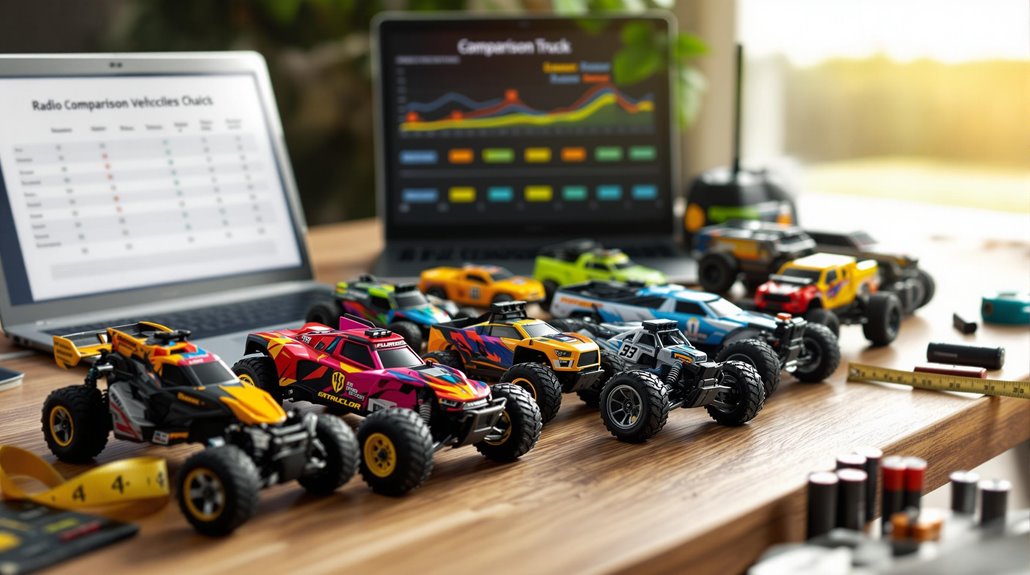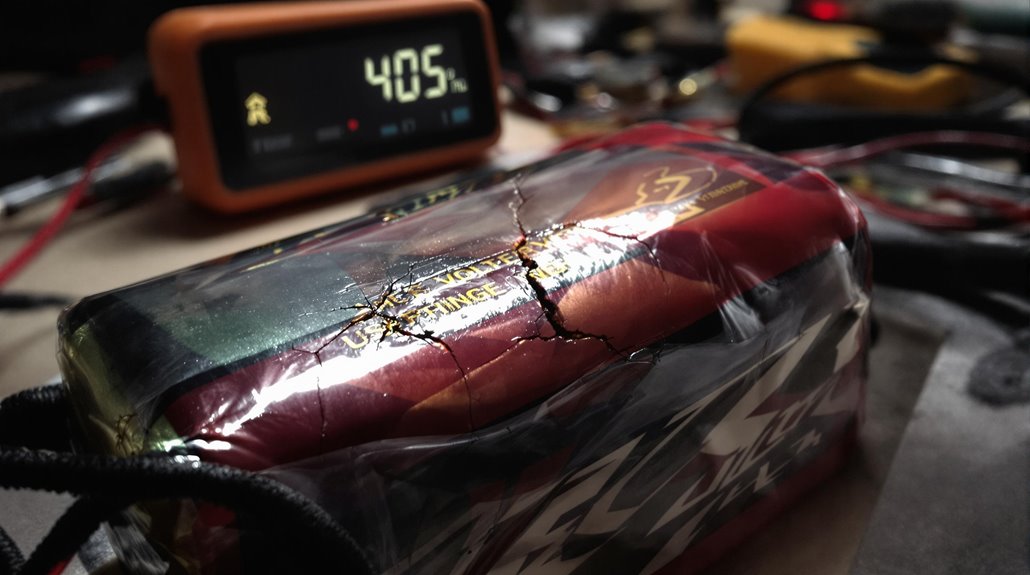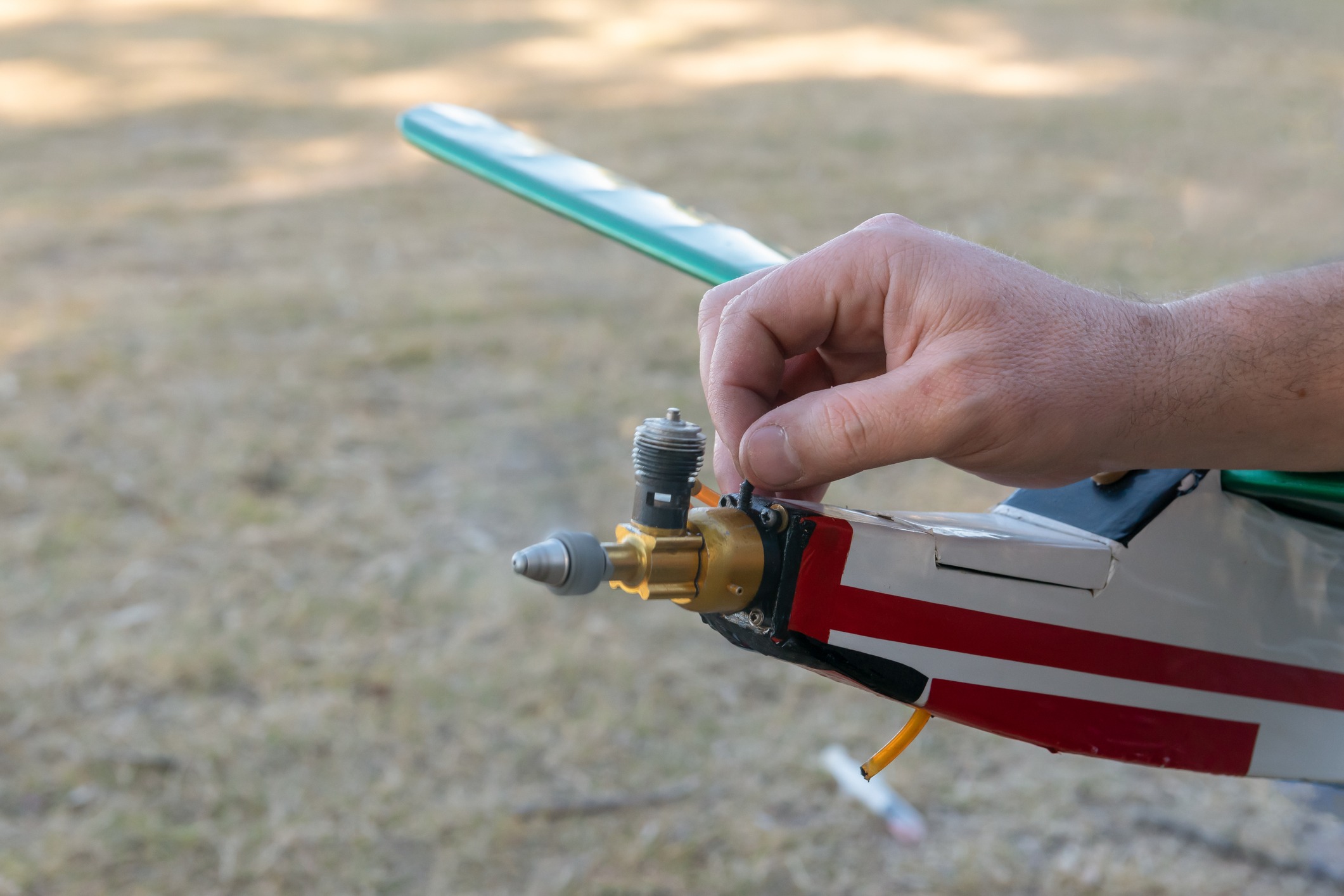Why Your RC Boat Needs a Water Cooling System
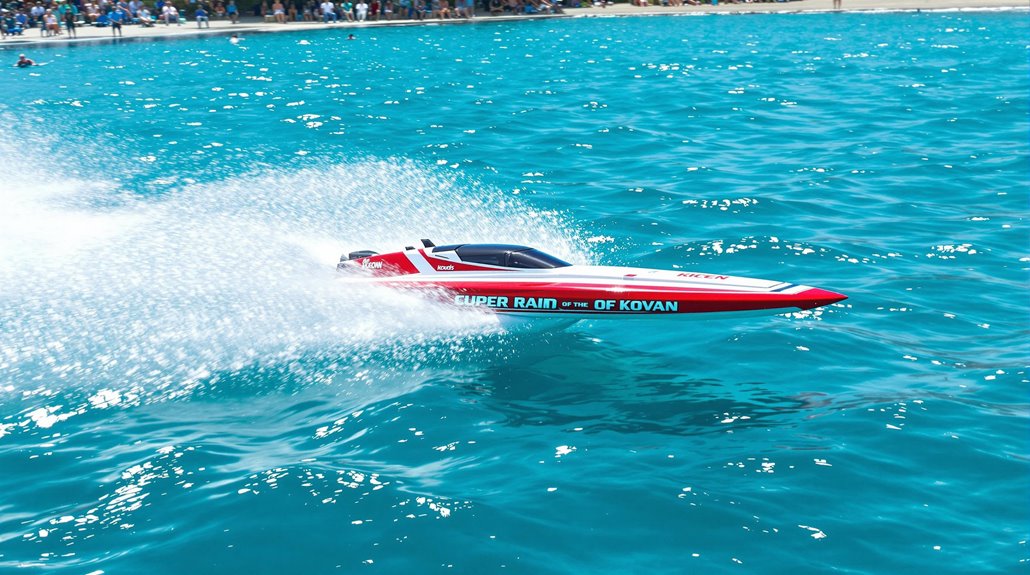
Your RC boat needs a water cooling system because effective heat management is crucial for optimal performance. As your boat runs, the motor and ESC generate significant heat, which can lead to overheating and even equipment failure. A water cooling system helps maintain safe operating temperatures, especially during intense use when propeller drag increases heat. This not only enhances reliability but also extends the lifespan of your boat's components. By integrating this system, you ensure smooth, prolonged operation for your high-performance setups. Stick around to discover tips and best practices for setting up your own water cooling system.
Key Takeaways
- Water cooling systems prevent overheating of motors and ESCs, ensuring optimal performance during intense use of RC boats.
- Effective thermal management extends the lifespan of electric boat components, reducing the risk of equipment failure.
- RC boats generate more heat than land vehicles, making water cooling critical for safe operational temperatures.
- Proper cooling enhances overall reliability and efficiency, especially in high-performance setups with larger propellers.
- Monitoring temperatures and managing heat through water cooling significantly improves the enjoyment and longevity of your RC boating experience.
Importance of Water Cooling
When you operate an RC boat, managing heat is crucial, especially since motors and electronic speed controllers (ESCs) generate significant amounts of it. Without proper cooling, overheating can lead to serious performance issues and potential equipment failure. Water cooling systems play a vital role in maintaining safe operational temperatures, particularly when you're pushing your boat to its limits.
The continuous drag from propellers in RC boats creates more heat than you'd encounter in land vehicles, making effective cooling essential for optimal performance. If you're running setups under heavy loads or using larger propellers, the risk of overheating increases significantly. Monitoring temperatures after initial runs is a smart strategy to prevent overheating and extend the lifespan of your motor and ESC.
It's crucial to consider the differences between electric or nitro power sources, as each has distinct cooling requirements and maintenance needs. Consider setups like the Mamba Monster ESC, rated at 120A continuous, and the Feigao 12XL motor, rated at 55A. Both can greatly benefit from water cooling to ensure they don't overheat during intense use.
By investing in a water cooling system, you're not just enhancing your RC boat's performance; you're also protecting your investment and ensuring countless hours of thrilling operation on the water.
Materials Needed
Gathering the right materials is crucial for building an effective water cooling system for your RC boat. Start with a 3-foot piece of 5/32 K&S aluminum tube; this will form the cooling coil essential for maintaining optimal temperatures during operation. You'll also need brass 5/32 K&S tubing for the water pickup, ensuring efficient water intake for cooling.
To connect the water pickup to the cooling coil and your electronic speed controller (ESC), grab some medium silicon fuel line. This material offers both flexibility and durability, which is vital for navigating the challenges of RC boating. You'll want to ensure that all connections are secure, so having 5-minute epoxy on hand is necessary for bonding the components effectively.
Lastly, don't forget to get some salt. It plays an important role in filling the aluminum tubing during the coil formation process, providing rigidity and shape retention. Once the coil is shaped, you can remove the salt, leaving you with a solid cooling structure ready for action. With these materials, you're on your way to building a reliable water cooling system for your RC boat.
Installing the Water Pickup
To install the water pickup on your RC boat, start by drilling a 3/16 inch hole about 3/4 of the way forward from the transom and 3/8 inch from the keel using a 5/32 inch drill bit. After drilling, reinforce the hull around the hole with a balsa or plywood doubler. This provides added support against stress and potential leaks. Next, smooth the tapered edges of the drilled hole.
This step is crucial to prevent damage to the hull and help achieve a secure fit for the water pickup tubing. Position the tubing carefully, ensuring it doesn't interfere with other hardware on your boat for optimal performance. Finally, connect everything using medium silicon fuel line for flexible and secure connections between the water pickup and the cooling system.
This ensures efficient water flow throughout the system. Consider investing in a brushless motor for enhanced power and compatibility with modern batteries, which can significantly improve your RC boat's performance and durability.
Creating the Cooling Coil
Creating an effective cooling coil is essential for keeping your RC boat's motor and ESC at optimal temperatures. You can easily create a cooling coil using 5/32 brass tubing, which circulates water efficiently to cool your components. Start by filling the brass tubing with salt to maintain its shape while you form it into a U-shape. This process helps prevent kinks that could impede water flow.
Wrap the tubing around a D battery to achieve a consistent and uniform coil formation. This design enhances heat dissipation, allowing for better cooling performance. After shaping the coil, remember to remove the salt to ensure smooth water circulation. Once your coil is formed, crimp the ends to prevent deformation and secure a tight fit when connecting it to your water system.
This step is crucial to avoid leaks and ensure that your cooling coil functions effectively. A well-installed cooling coil is vital for maintaining optimal temperatures during operation, preventing overheating, and prolonging the lifespan of your RC boat's components. With the right setup, you can enjoy longer run times and improved performance on the water. To achieve high-speed performance, consider how efficiently your cooling system works alongside the power of your RC motor.
Completing the Cooling System
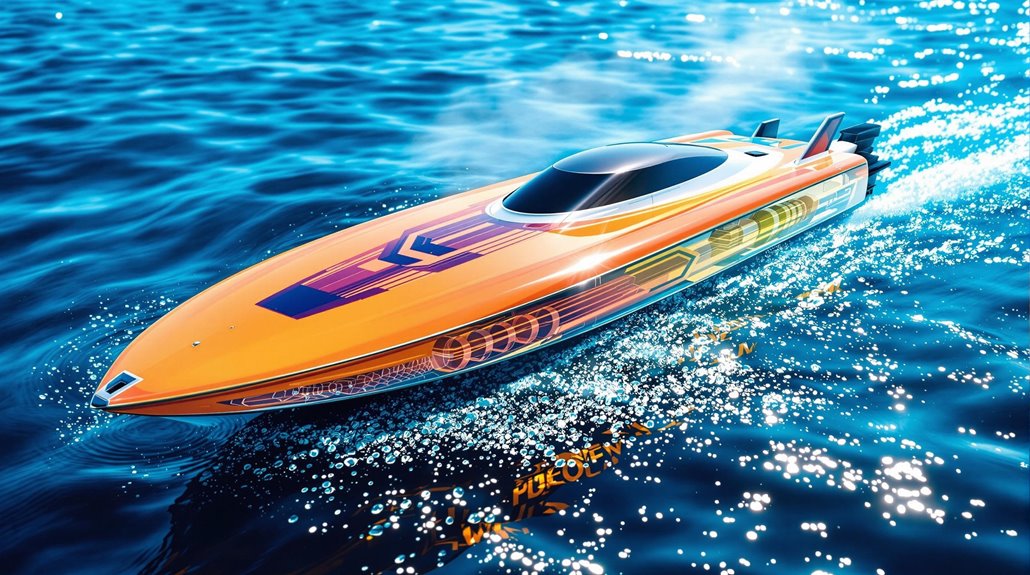
After shaping your cooling coil, the next step is to complete the cooling system for your RC boat. First, ensure the motor is properly installed with the cooling coil positioned for easy connections to the water intake and the Electronic Speed Controller (ESC).
Next, cut and fit medium silicon tubing between the cooling coil and the ESC to facilitate effective water flow. You'll also need to create a water exit using a small piece of brass tubing, allowing warm water to expel from the system after circulating through the cooling coil.
Incorporating a thermostat into your design is crucial; it'll help regulate water flow, ensuring efficient heat removal from both the motor and the ESC during operation. Remember, restricting water flow within the cooling system optimizes heat exchange, preventing overheating and extending the lifespan of your components. It's also important to consider battery replacement availability for long-term use, which ensures continued performance without interruption.
Here's a quick checklist to visualize what you need:
- Medium silicon tubing for connections
- Brass tubing for water exit
- Thermostat for temperature regulation
- Secure mounts for cooling components
- Proper sealing materials to prevent leaks
This setup will keep your RC boat running cool and efficiently!
Equipment Specifications
When selecting equipment for your RC boat, it's essential to consider the specifications of both the motor and the ESC to ensure optimal performance. The Mamba Monster ESC, rated for a continuous current of 120A, is ideal for high-performance applications, especially where effective cooling is crucial. Pairing it with the Feigao 12XL motor, which has a maximum rating of 55A, requires careful attention to heat management. This combination performs best under specific conditions, particularly when operating on 6 cells in a SV27 configuration.
While this setup allows for manageable amp draws, monitoring temperatures remains vital to prevent overheating during extended runs or heavy loads. Keep in mind that the size of your propeller also plays a significant role. Larger props increase the load on both the motor and ESC, leading to higher amp draw and more heat generation. Properly matching your motor and ESC ratings isn't just a suggestion—it's essential for performance and longevity.
Mismatched components can cause excessive heat and lead to failure, so make sure your selections are compatible for a smooth and efficient boating experience. For optimal performance, consider using lithium-polymer batteries, which offer higher mAh values and better current retention, enhancing your boating experience.
Testing and Monitoring
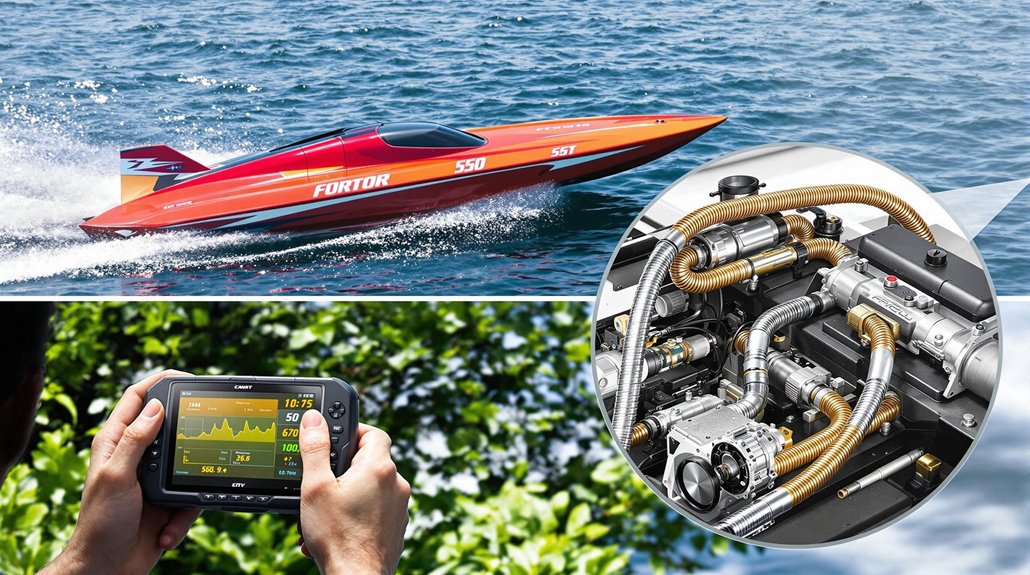
Monitoring and testing your RC boat's cooling system is vital for ensuring optimal performance and preventing overheating. Start with initial runs lasting about 30 seconds to keep a close eye on temperatures and confirm the cooling system's functionality. This brief testing phase allows you to identify any immediate issues. Once you're comfortable with the results, gradually increase the runtime while continuously monitoring temperature changes.
Here are some key steps to follow:
- Check for leaks in the water cooling system; even minor ones can lead to problems.
- Use waterproof hatches to protect your electronic components from water exposure.
- Regularly monitor motor and ESC temperatures during operation to catch potential overheating.
- Document temperatures after each run to track performance over time.
- Adjust your cooling system as needed based on your monitoring findings.
Incorporating these practices into your routine will help you maintain your RC boat's cooling system effectively. Choosing RC car types based on your environment can also inform how you approach maintaining RC vehicle performance. By prioritizing testing and monitoring, you can prevent overheating issues before they escalate, ensuring a longer lifespan for your equipment and more enjoyable runs on the water.
Setup Considerations
Setting up a water cooling system for your RC boat requires careful attention to several key factors to ensure optimal performance. First, position the water pickup correctly—typically 3/4 forward of the transom and 3/8 from the keel. This placement maximizes water intake during operation. Next, consider the propeller size; using a smaller prop for initial testing can help mitigate excessive heat buildup and manage amp draw effectively.
In high-performance setups, incorporate water jackets on your motors to enhance cooling efficiency. This addition is crucial, especially if you're running powerful components that generate significant heat. During initial runs, monitor temperatures closely, gradually increasing runtime to confirm your system operates within safe limits. This step will also help you identify any potential leaks or cooling issues that may arise.
Lastly, don't overlook ESC cooling solutions. If you're using high amp-rated ESCs, like the Mamba Monster ESC rated at 120A, you may need additional cooling measures to prevent overheating. By addressing these setup considerations, you'll ensure your RC boat runs smoothly and efficiently, allowing for an enjoyable experience on the water.
Community Insights
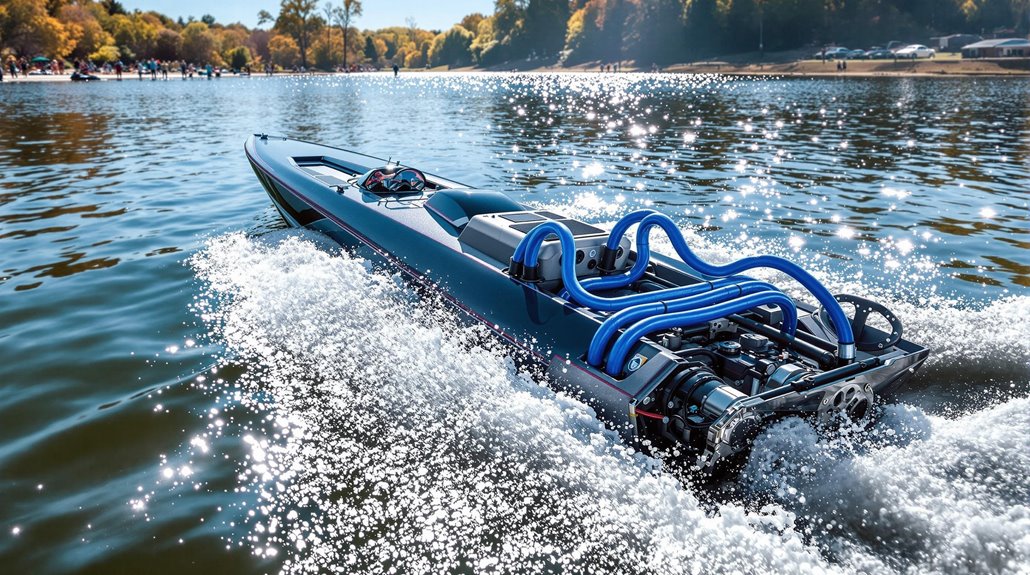
Engaging with the RC boating community can provide valuable insights into the importance of water cooling systems for your boat. Experienced users stress that these systems are crucial for managing the heat generated by motors and ESCs during extended operation. Many forum discussions highlight the significance of monitoring temperatures after your initial runs, ensuring that your cooling system is effectively preventing overheating.
Here are some insights from the community:
- Effective water cooling can extend the lifespan of your electric boat components.
- Users recommend specific materials and configurations ideal for various boat designs.
- Many seasoned hobbyists advocate for water cooling in high-performance setups.
- Some discussions reveal that less demanding systems might not require cooling.
- Sharing experiences helps newcomers learn the best practices for setup.
- Scale modeling provides a sense of accomplishment upon completion, similar to how mastering the setup of an RC boat's cooling system can be fulfilling.
Trends in Water Cooling
As you explore the insights shared by the RC boating community, it's clear that the trend toward water cooling systems is rapidly gaining momentum. With the increasing power of electric motors, managing heat effectively has become crucial for performance. Enthusiasts are pushing the limits of speed and efficiency, making water cooling systems a standard feature in many high-performance setups. These systems enable higher amp draws without the risk of overheating, ensuring your boat runs smoothly.
The integration of water-cooled electronic speed controllers (ESCs) is also on the rise, replacing traditional heat sinks to enhance thermal management. This shift not only improves cooling efficiency but also streamlines the overall design of your setup. Additionally, DIY water cooling solutions are gaining traction among hobbyists, with forums and community resources offering guidance for custom builds using readily available components.
As electric-powered models dominate the RC hobby sector, innovations in water cooling technology are accelerating. These advancements lead to more compact and efficient systems, ultimately improving the reliability and longevity of your RC boat. Embracing these trends will help you stay ahead in the thrilling world of RC boating.


